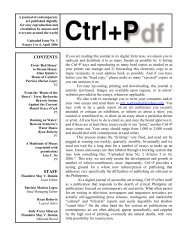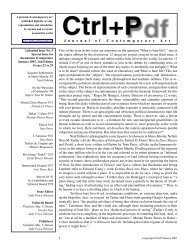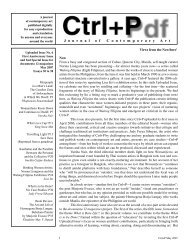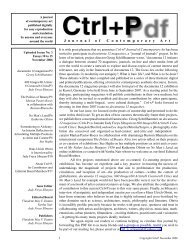Issue 15 - Pdf Ctrl+P - CTRL+P: a journal of contemporary art
Issue 15 - Pdf Ctrl+P - CTRL+P: a journal of contemporary art
Issue 15 - Pdf Ctrl+P - CTRL+P: a journal of contemporary art
You also want an ePaper? Increase the reach of your titles
YUMPU automatically turns print PDFs into web optimized ePapers that Google loves.
in the roster <strong>of</strong> the Luz Gallery. In other words, there seemed to be a singular circuit<br />
through which a distinct mode <strong>of</strong> modernism found its relay: this was for all intents and<br />
purposes on the watch <strong>of</strong> Luz, who was widely respected for his mandarin sensibility and<br />
fastidiousness as <strong>art</strong>ist, curator, and administrator. We note this tyranny <strong>of</strong> taste: “Actually,<br />
my principal reason was simply to provide <strong>art</strong> with the setting and importance it<br />
deserves. Bad painting deserves obscurity, but painting that deserves to be shown must<br />
Left: Arturo Luz. For Xavier Gonzales,<br />
1978. Painted burlap on wood,<br />
102.9 x 221.6 cm<br />
Middle: Arturo Luz, Untitled. 2007. Metal<br />
Right: Arturo Luz. Nightglow. 1960.<br />
Oil on canvas. 84.5 x 181 cm.<br />
Image courtesy <strong>of</strong> the Cultural Center<br />
<strong>of</strong> the Philippines.<br />
be shown well. Surprisingly, virtually all other galleries in Manila ignore this obvious<br />
truth…More obvious though less popular is my notion that galleries have to be dictatorial<br />
in matters <strong>of</strong> taste and quality…The point is that galleries have certain functions and<br />
responsibilities other than to make pr<strong>of</strong>it…Above all, it (the gallery) should mold taste<br />
and exercise a certain degree <strong>of</strong> critical judgment.” 34 This acuity in hindsight made the<br />
Gallery a veritable bellwether <strong>of</strong> the first Thirteen Artists awardees in 1970: in 1968, the<br />
20 Artists exhibition was practically the mirror-image <strong>of</strong> the latter.<br />
Moreover, Luz proved to be a vital element in the <strong>art</strong> world because <strong>of</strong> his links<br />
to a very influential circle <strong>of</strong> standard-setters and opinion-makers in the sixties and the<br />
seventies. We may trace the lineage <strong>of</strong> this elite to Fernando Zobel whose role as <strong>art</strong>ist,<br />
benefactor, and intellectual shaped hegemonic formations in the <strong>art</strong> world. His bequest<br />
to the Ateneo was the nucleus <strong>of</strong> the Ateneo Art Gallery, the first institution <strong>of</strong> modern<br />
<strong>art</strong> in the Philippines that p<strong>art</strong>ly enhanced the auspice <strong>of</strong> Luz by way <strong>of</strong> exhibitions <strong>of</strong><br />
his <strong>art</strong>, including the ten-year retrospective that Ateneo pr<strong>of</strong>essor and critic Emmanuel<br />
Torres curated in 1966, the same year Luz received the Republic Heritage Award. Torres<br />
likewise wrote a book on his drawings and at one time conceptualized an exhibition <strong>of</strong><br />
Philippine <strong>art</strong>, running the length from the nineteenth century master Juan Luna to Luz.<br />
This clique also included the pianist and theater <strong>art</strong>ist Leandro Locsin, chief architect <strong>of</strong><br />
Imelda and the Ayalas, and later Roberto Chabet, who exhibited his early Malang-like<br />
works at the Luz Gallery. More importantly, they thought highly <strong>of</strong> each other. When<br />
asked who among the local painters <strong>of</strong> his time he esteemed most, Zobel would point to<br />
Luz if he “had to name a single person...his clarity, the pr<strong>of</strong>ound honesty <strong>of</strong> his work,<br />
the elegance <strong>of</strong> his restraint, have to do with everything I admire.” 35 Luz for his p<strong>art</strong> is<br />
indebted to Chabet for the evolution <strong>of</strong> his collages. The crucial coordinates would be<br />
Luz, Locsin, and Chabet. Locsin and Luz may have been kindred spirits. A story has<br />
gone around that one time when the two were asked to select ten objects, they had similar<br />
choices. They were attuned to the same wavelength in terms <strong>of</strong> their regard for space,<br />
intellect, and class affectation. Albano, who came from Ilocos Norte and was not reared<br />
in privilege, did not belong to this orbit.<br />
All told, as Alfredo Roces would put it: “Luz had the gallery, Locsin had the building<br />
and clientele and Zobel had the theories and even the patronage.” 36 In this regard, Tessie<br />
Luz relates that “there was a small group <strong>of</strong> collectors who revolved around Zobel and<br />
Lindy Locsin.” 37 Furthermore, Zobel had a hand in the founding <strong>of</strong> the Ayala Museum<br />
in 1961, on the heels <strong>of</strong> the establishment <strong>of</strong> the Ateneo Art Gallery, the Luz Gallery,<br />
and the Lopez Memorial Museum the previous year; it opened to the public in 1967.<br />
In 1974, it moved to Makati in a building designed by Locsin. The Ayalas nurtured the<br />
country’s oldest business house and was its pioneer monopolist. 38 Zobel’s cousin Jaime<br />
Zobel de Ayala, the industrialist and tycoon whose family practically owns the financial<br />
district Makati and the country’s gated enclaves, was CCP’s first Executive Director<br />
and President. These connections are very telling. The history <strong>of</strong> Ayala as a firm and<br />
proto-conglomerate and how Jaime would try to elide class in the production <strong>of</strong> culture<br />
through the CCP are equally compelling: “The Center, they say, is only for the affluent.<br />
42 <strong>Ctrl+P</strong> September 2009







